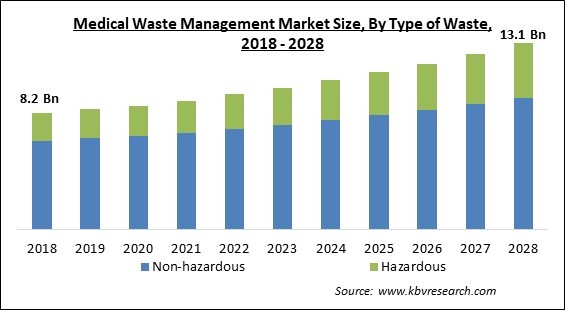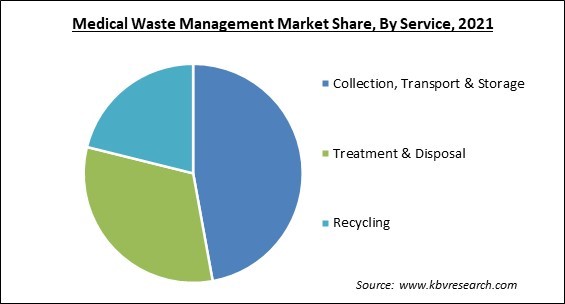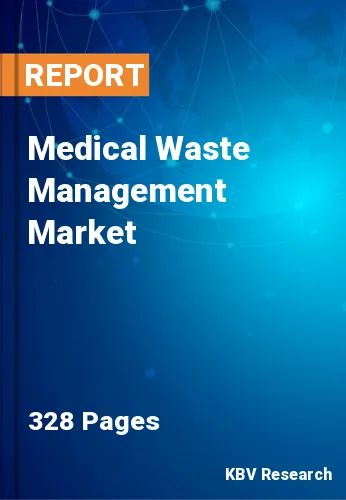The Global Medical Waste Management Market size is expected to reach $13.1 billion by 2028, rising at a market growth of 5.5% CAGR during the forecast period.
Anything waste that includes infectious materials is referred to as medical waste, sometimes referred to as hospital waste. Along with trash from the manufacturing of biomedical waste with medical or laboratory origin (such as packaging, old bandages, infusion kits, etc.), it might also include waste from research labs that contains biomolecules or organisms that are generally prohibited from being released into the environment. Whether or not contaminated by blood and its propensity to cause harm when not carefully regulated and dispersed, the disposed sharps are considered medical waste. Biowaste is one category of waste. Medical waste can be either liquid or solid.

The handling of biomedical waste using a variety of services, including autoclaving, chemical treatment, and burning, is referred to as medical waste management. The byproduct of hospitals, the research sector, laboratories, and surgery centres is medical waste. This market's expansion is a result of rising medical waste volumes, strict regulations enacted to handle them effectively and sustainably, and the expansion of healthcare infrastructure. Additionally, the market is growing as a result of an increase in awareness campaigns for managing medical waste.
The increasing application of stringent environmental and safety requirements by governments throughout the world is one of the key reasons driving the medical waste management industry. Various federal, state, and local regulations that have established a number of guidelines for the many categories of medical wastes govern this field. The containment, transportation, labelling, storage, and processing of medical waste are generally governed by local and state rules. Any medicine that satisfies the requirements for becoming a hazardous waste must be properly disposed of in the United States in accordance with the Resource Conservation and Recovery Act of the U.S. Environmental Protection Agency.
The expansion in aging population, rise in chronic disease incidence, and advancements in technology for the efficient treatment of medical waste are the main factors driving the growth of the market for medical waste management. India created roughly 45,308 tonnes of biomedical waste during June 2020 and May 2021, as per the Central Pollution Control Board (CPCB), as a result of an increase in the usage of various diagnostic procedures and the treatment of COVID-19 patients. Two out of every three senior individuals had a chronic condition in 2020, as per the Longitudinal Ageing Study in India (LASI). Government initiatives for the efficient handling of medical waste are another factor driving market expansion.
The market-driver for the healthcare business, medical waste management, has experienced tremendous expansion. The demand for medical waste management has expanded due to a growth in hospitals, labs, research institutes, mortuaries, autopsy facilities, blood banks, and collection operations around the world. Hospitals, dentist offices, clinics, blood banks, medical research facilities, and laboratories all produce medical waste on a regular basis.
In affluent nations like the US and UK, there is a rise in activities of awareness programmes and conferences to raise understanding of proper medical waste management and prevent medical waste mistreatment. Government and non-government organizations are working by raising public awareness of the right method for getting rid of medical waste in a non-hazardous state. Thus, this growing awareness programs among healthcare institutions and the stringent government regulation would accelerate the growth of the market during the forecast period.
Hospitals, healthcare facilities, and pharmaceutical firms must make a sizable capital investment in the gathering and proper processing of waste in order to minimize environmental pollution. The disposal of both hazardous and non-hazardous medical waste calls for sophisticated technology and a large financial commitment. An incinerator facility must be installed, which is an expensive operation. Especially, the expenses associated with building the infrastructure and running the incineration facilities are extremely substantial.
On the basis of type of waste, the medical waste management market is bifurcated into Non-hazardous Waste and Hazardous Waste (Infectious & Pathological, Sharp Waste, Pharmaceutical Waste and Others). Hazardous Waste segment procured a significant revenue share in the medical waste management market in 2021. Anything that can have a non-infectious impact on humans is considered a hazardous waste. This can contain items like medical and industrial chemicals, outdated medications, and sharps (scalpels, needles, lancets, etc.). In addition, there are many companies that are taking efforts to dispose all the waste from healthcare firms.

Based on Component, the medical waste management market is segmented into Collection, transport and storage services; Treatment & disposal services (Incineration, Autoclaving and Chemical Treatment & Others); and Recycling services. The collection, transportation and storage services segment procured the highest revenue share in the medical waste management market in 2021. The treatment, collection, transport & storage services, and disposal services, as well as recycling services, are the market segments for medical waste management. In addition, there is growing adoption of technologies in the healthcare industry, which is accelerating the growth of the segment over the forecast period.
By treatment site, the medical waste management market is divided into Offsite Treatment and Onsite Treatment. Onsite Treatment segment recorded a significant revenue share in the medical waste management market in 2021. It is caused by a rise in biomedical waste volume and the emergence of important factors for efficient handling of medical waste. Along with that, there is increase in the efforts by companies operating in healthcare industry to dispose all the medical waste generated across the firm.
Based on waste generator, the medical waste management market is fragmented into Hospital & diagnostic laboratories and Other waste generator. The hospital & diagnostic laboratories segment garnered the highest revenue share in the medical waste management market in 2021. It is mostly because there are more awareness-raising initiatives for managing medical waste in industrialized nations. Hospitals typically produce a variety of garbage, including medical, office, and domestic waste.
| Report Attribute | Details |
|---|---|
| Market size value in 2021 | USD 9.1 Billion |
| Market size forecast in 2028 | USD 13.1 Billion |
| Base Year | 2021 |
| Historical Period | 2018 to 2020 |
| Forecast Period | 2022 to 2028 |
| Revenue Growth Rate | CAGR of 5.5% from 2022 to 2028 |
| Number of Pages | 328 |
| Number of Tables | 600 |
| Report coverage | Market Trends, Revenue Estimation and Forecast, Segmentation Analysis, Regional and Country Breakdown, Companies Strategic Developments, Company Profiling |
| Segments covered | Type of Waste, Service, Treatment Site, Waste Generator, Region |
| Country scope | US, Canada, Mexico, Germany, UK, France, Russia, Spain, Italy, China, Japan, India, South Korea, Singapore, Malaysia, Brazil, Argentina, UAE, Saudi Arabia, South Africa, Nigeria |
| Growth Drivers |
|
| Restraints |
|
Region-wise, the medical waste management market is analyzed across North America, Europe, Asia Pacific and LAMEA. North America emerged as the leading region in the medical waste management market with the highest revenue share in 2021. The rise in the number of elderly people is responsible for the expansion of the medical waste management industry in North America. Owing to the prevalence of a highly developed healthcare system and a growth in infectious and chronic diseases, which call for cutting-edge medical and surgical resources and treatments, the US maintains the greatest market share in North America for medical waste management.
Free Valuable Insights: Global Medical Waste Management Market size to reach USD 13.1 Billion by 2028
The market research report covers the analysis of key stake holders of the market. Key companies profiled in the report include Veolia Environnement S.A., Waste Management, Inc., Clean Harbors, Inc., Remondis SE & Co. KG (Rethmann Se & Co. Kg), Biomedical Waste Solutions, LLC, Daniels Sharpsmart, Inc. (Daniel Health), Sharps Compliance, Inc., Republic Services, Inc. (Cascade Investment Group, Inc.), EcoMed Services (Tristel Plc) and Stericycle, Inc.
By Type of Waste
By Service
By Treatment Site
By Waste Generator
By Geography
The Medical Waste Management Market size is projected to reach USD 13.1 billion by 2028.
Rise in The Amount of Healthcare Wastage are driving the market in coming years, however, Requirement of High Investment by Healthcare Companies restraints the growth of the market.
Veolia Environnement S.A., Waste Management, Inc., Clean Harbors, Inc., Remondis SE & Co. KG (Rethmann Se & Co. Kg), Biomedical Waste Solutions, LLC, Daniels Sharpsmart, Inc. (Daniel Health), Sharps Compliance, Inc., Republic Services, Inc. (Cascade Investment Group, Inc.), EcoMed Services (Tristel Plc) and Stericycle, Inc.
The Offsite market is generating high revenue in the Global Medical Waste Management Market by Treatment Site in 2021, thereby, achieving a market value of $8.9 billion by 2028.
The Non-hazardous market is leading the Global Medical Waste Management Market by Type of Waste in 2021, thereby, achieving a market value of $9.3 billion by 2028.
The North America market dominated the Global Medical Waste Management Market by Region in 2021, thereby, achieving a market value of $4.6 billion by 2028.
Our team of dedicated experts can provide you with attractive expansion opportunities for your business.

